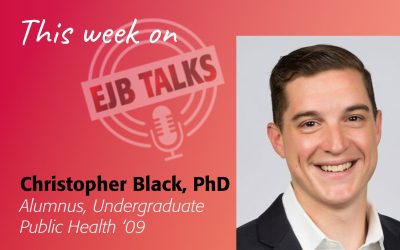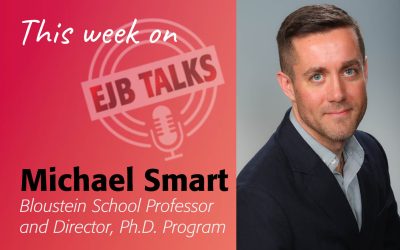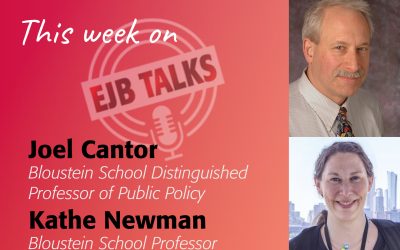Transcript:
Stuart Shapiro
Welcome to EJB Talks. I’m Stuart Shapiro, the dean of the Bloustein School. And the purpose of this podcast is to highlight the work that my colleagues and our alumni are doing in the fields of policy, planning, and health.
For our third episode of this 10th season of EJB Talks, we’re talking to Assistant Professor Emily Parker, who is in her first year at the school and who teaches in the public health and public policy programs. Welcome to the podcast, Emily!
Emily Parker
Thanks so much! Great to be here.
Stuart Shapiro
So, I almost always start these out with origin story questions. How did you become interested in healthcare and community health centers?
Emily Parker
Yeah, so I… immediately after college, jumped into kind of, the most exciting historical moment in health policy since the 1960s. That was the implementation of the Affordable Care Act. I had the pleasure of working at the New York State Health Foundation, which is a public, nonprofit funder for all sorts of health-related projects in New York State and New York City. And our goal was to assist with the state’s efforts to enroll more people in health insurance. Which, of course, was a gigantic effort across the country and New York was very much on top of it. So I got exposure, working with state policymakers, as well as groups on the ground who were actually working on enrolling individuals in health insurance.
And one of those kinds of entities were community health centers, which are otherwise known as federally qualified health centers. And so I worked through that job in partnering with FQHCs around New York State to try to, kind of, supplement and enhance the Affordable Care Act implementation. And also to think about how to increase their own capacity and the ability of patients who are perhaps newly insured, or on Medicaid, to access health care. So then, when I moved on to doing my Ph.D. in public policy, I realized that there’s this, kind of, a wide gap in terms of literature and knowledge. And not many social scientists knew about the community health center program.
So I was doing primarily research in sociology and demography and economics and realized that there is a big opportunity here to bring, kind of, the analytic tools and the theories of social science to this policy area. So that’s how I started.
Stuart Shapiro
So I’d wager that it’s not just social scientists that don’t know a lot about federally qualified health centers or community health centers, but probably a fair amount of our audience as well. And so, can you explain what they are and where they come from?
Emily Parker
Yes, you are not alone if you have not heard of this program. I’m very accustomed to telling people about my research. What is this? What is this policy? So it dates back to the 1960s, the war on poverty. And it’s a pretty simple premise. These are federally funded clinics in medically underserved areas. So high poverty places. And they tend to have real scarcities of providers.
So, the government funds these programs through a competitive grant-making process. Organizations usually apply for the status to become a federally qualified health center. And what happens is that subsidizes the care for for either uninsured patients or those who are on Medicaid. So the really unique thing about FQHCs and the reason that I am passionate about studying them, is that they offer primary care regardless of ability to pay. So in the broader health care system, that’s quite unusual.
We have a very, you know, profit-driven healthcare system that you have to have insurance or financial means to access healthcare. So FQHCs are one of the few places that you can go and not be turned away from care. So that means they primarily serve low-income patients and racial and ethnic minorities. As well as you know, homeless individuals and public housing residents and migrant farmworkers. They have these special population groups so it’s really the backbone of our health care safety net.
Stuart Shapiro
And yet, unlike Medicaid, or unlike food stamps, or even, I’d argue TANF. We don’t see these in the news. We don’t see them at the center of debates about the safety net Why is this?
Emily Parker
Well, there is a long version and a short version. (laughing) I will try to keep it too short version. But there’s a really fascinating political history going back to the early origins of the program. Where they had many successful strategies to become politically popular and avoid this kind of partisanship that we see across most of our social welfare programs now. A lot of that had to do with… starting within the executive branch. It was in the Office of Economic Opportunity. And it started off as a relatively small and modest program and grew slowly. it developed a really, robust grassroots advocacy network that connected with really influential politicians at the congressional level to create kind of a stake for them.
And also like a… what’s fascinating to me is that there’s a really compelling economic argument for these centers that I think resonated across the political spectrum. That they’re providing a service that the healthcare market just wouldn’t be incentivized to otherwise provide. And that’s because of the nature of them being in low-income communities, where medical professionals, doctors, otherwise might not or may not choose to serve, because it’s not financially lucrative.
So this really compelling economic argument from the beginning was important to their political success. As well as the widespread targeting, they initially targeted primarily urban, black communities and Hispanic migrant communities. But then, around the mid-1970s, shifted to a rural white population. And so there was this lack of racialization. So yeah, it’s a really remarkable case study of how a policy targeting the poor can become bipartisan. And nowadays, you’ll see Republicans embracing FQHCs, just as much as the most, you know, liberal Democrats. President George W. Bush was one of the programs biggest proponents, just like, you know, Senator, Bernie Sanders. And you can’t imagine, you know, more polar opposites there, right? So it really speaks to the, you know, resonance across the political spectrum.
Stuart Shapiro
Right. It’s a little bit, you know, you made me think of military bases there. You know, everyone’s got one in their district and nobody wants to close them.
Emily Parker
Exactly, there’s a real incentive to keep them open, to serve the constituents.
Stuart Shapiro
Right, right. That’s fascinating. So in a recent article that you wrote about these FQHCs, which are, as you noted, still publicly funded. You use them to sort of discuss the broader trend in government toward privatization. Can you sort of talk a little bit about what you were getting at with that argument? Because I found that fascinating.
Emily Parker
Yeah, thank you. So that study was based off of qualitative interviews that I did at an FQHC and a rural clinic. And from from talking to patients, as well, as providers and staff, I really wanted to understand the experience at the health center as well as their views toward the government. And what I found in my study was that, most patients really had very little awareness that this was actually a government-funded program. Which speaks to the broader trend of privatization. So, since around the 1980s–some scholars debate when it started– our federal government has channeled most of its, or large share of its, funding toward nonprofits to deliver public programs. And so FQHCs are a classic example of that.
And what does that mean for patients? You know, that was my question. Generally speaking, it means that they did not associate their FQHC with the government, which tended to mean that they felt less stigma going to their FQHC than they did going to say, you know, the local government social services office. And they really drew this distinction between, that doesn’t feel like government when I go to the FQHC. And that’s largely because of this, like, private funding mechanism through federal grants.
Stuart Shapiro
Interesting. All right. Yeah. I have have so many questions. Yeah. Can you tie that a little bit to what we just discussed? The, you know, it’s got this political support, yet people don’t see it as part of the government. And how does that work?
Emily Parker
Exactly. And this ties in with a lot of political science in the last 20 years or so that’s documented this trend of, many government programs being submerged, or hidden from public view. And what a lot of political scientists have concluded that this has, you know, deep concerns for democracy and political participation. Because people are unaware of the services that the government is offering them, which could have political implications. And what I found, you know, in the community where I did my research was primarily conservative. Hostile towards the government, it was a Trump, President Trump won the county in 2016 right before I did my fieldwork.
And when I told them that this was a government-funded program, you may expect them to have felt, you know, some animosity toward the government or maybe less approval that this was an appropriate place to be receiving medical care. But I actually found quite the opposite, that they were much more welcoming that of the government’s intervention in this way. Because they felt like their community had been left behind. And it’s, you know, in the Rust Belt, and they’d lost a lot of their blooming economy of the of the early, you know, 1980s and 1990s. So, they saw this as a very justified government intervention and one that they should have, that there should be more of.
So while you may expect people who are more right-leaning to be suspicious of programs like this, I actually found quite the opposite that they were, they were quite warm to it. However, the organization itself wasn’t going on and on about this being a government program. And that’s something that I think the FQHC program more broadly, can think about. You know, the program’s role in not broadcasting the government, which has pros and cons. One, you know, pro being that the patients didn’t feel as stigmatized going there. But the con being this lack of kind of credit that’s being given to government for doing something that they approve of.
Stuart Shapiro
Right. I mean, you think of the classic sign that you know, that behind this argument during the Affordable Care Act debate, keep your government hands off my Medicare, right? (laughing).
Emily Parker
(laughing) Exactly!
Stuart Shapiro
And we’ve gotten to the point with those programs that, people just see them as something they’re supposed to have, right? And it seems to some degree, FQHCs have done that. Although maybe not in the same way that Medicare does just by sort of length of time, or the fact that everyone gets it or something like that. It’s interesting.
Emily Parker
Yeah, and FQHCs are, they’re all tailored to their local communities, they have different names that often, you know, evoke some local reference point. You know, a mountain range or a lake or, you know, something that people know is my local clinic. And it doesn’t have a name like a government-sounding name. (laughing)
Stuart Shapiro
Right, right!
Emily Parker
They don’t, you know, generally speaking, they’ve renovated their facilities. They don’t present in a rundown fashion. And that’s what a lot of my interview respondents would say to me is, this doesn’t look like government. It’s nice. You know, it has… I had heard one person saying, they play cool music. They have new equipment. You know, so there’s this disconnect from the government. And in those ways, even though it is a publicly funded program from our taxpayers dollars.
Stuart Shapiro
I love that phrase looks like government!
Emily Parker
Exactly!
Stuart Shapiro
I would love to explore what that means.
Emily Parker
Yes!
Stuart Shapiro
What is something that “looks like government?” And you mentioned racialization, earlier. Is, “looks like government,” something that serves racial minorities? Is that what it means?
Emily Parker
Mmm hmm, that’s a great question. And one that my study can’t quite answer because it was a primarily white community. And I did have some evidence–I don’t know how far you got into the paper–I did have some evidence of a nearby FQHC that served a predominantly black population. And the patients that I interviewed describing it in more stigmatizing ways. So I do think there’s a, you know, an important element of racialization, and community context. And, you know, as well as who are the who are the providers there, how diverse they are, how they match with their community members. So these are all questions that I hope to continue exploring. You know, I’m new to New Jersey, but I hope to continue to work with FQHCs here. So if you’re listening, give me a call.
Stuart Shapiro
Along those lines, a lot of your work you’ve done, you’ve talked about place-based stuff, stuff. And you know, we’re an urban planning school. And so it’s a good place to do place-based stuff. And I’m wondering, with your transition to a school like this, and with your transition to New Jersey. You know, what are your thoughts? And where do you see your work going from here?
Emily Parker
Yeah, so you bring up the other kind of main area of my research, which was on federal place-based policies. Of which FQHCs are one. But what do we mean by place-based? These policies tend to use geographic characteristics to target funding. So they use, tend to use things like the percent poverty, the unemployment rate, other kinds of economic measures to determine eligibility and need for investment by the federal government.
And the interventions are targeted at a geographic unit level. So oftentimes, a neighborhood, or a county, or a city, will get funding to address, you know, various things. So this is work I’ve been doing for many years now with Professor Laura Tach at Cornell University. We identified all federal place-based policy programs going back to the 1990s. Through, you know, a couple years ago. And then we also found data to trace the funding over time and across places. So how much funding neighborhoods did or didn’t get from the federal government over this time period?
And we have a number of projects in this area, some focusing on different domains, so economic development policies. You may know new markets tax credits, or empowerment zones. There’s also housing policies like LIHTC, and HOPE VI that some of our listeners may be aware of. So where did these policies come up? We look for patterns of what places got them and what sort of effects they’ve had on neighborhoods.
So I very much come from a policy background. And I’m very excited to be at a school of urban planning as well. To learn from my planning colleagues on how they approach this kind of question from a different disciplinary toolkit than then the more policy. you know, sociology, demography, angle that I come at questions. I think I have a lot to learn from them methodologically as well as theoretically. And I’m very much hoping to, you know, continue these conversations with them and integrate it in my teaching since I get some planning students as well as undergrad, public health, and policy students.
Stuart Shapiro
Wonderful. Yeah, it sounds like you might even be going beyond health in some of these areas. Housing and a number of other programs that use geography as their basis. And we thank you very much for coming on the podcast today. It’s been a great conversation.
Emily Parker
My pleasure. Thank you so much.
Stuart Shapiro
Thank you as well to Tamara Swedberg and Karyn Olsen, who helped make this podcast happen. We’ll see you next week with another talk from another expert at the Bloustein School. Until then, stay safe.




